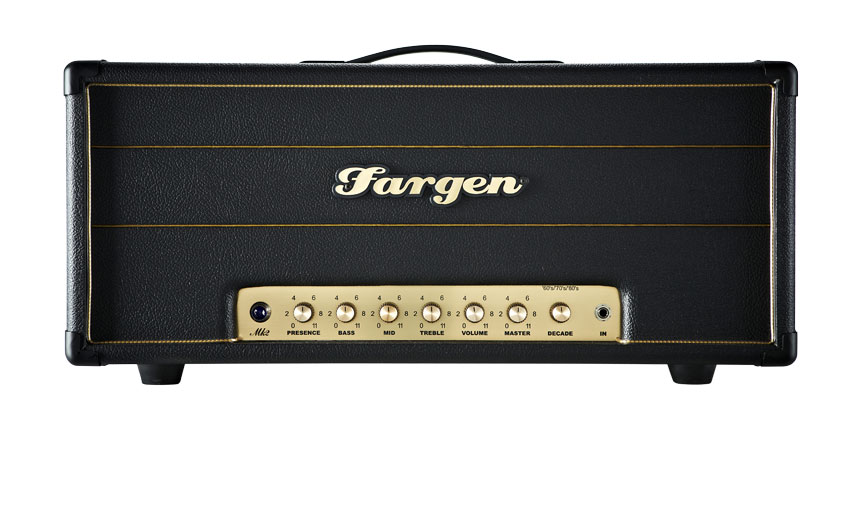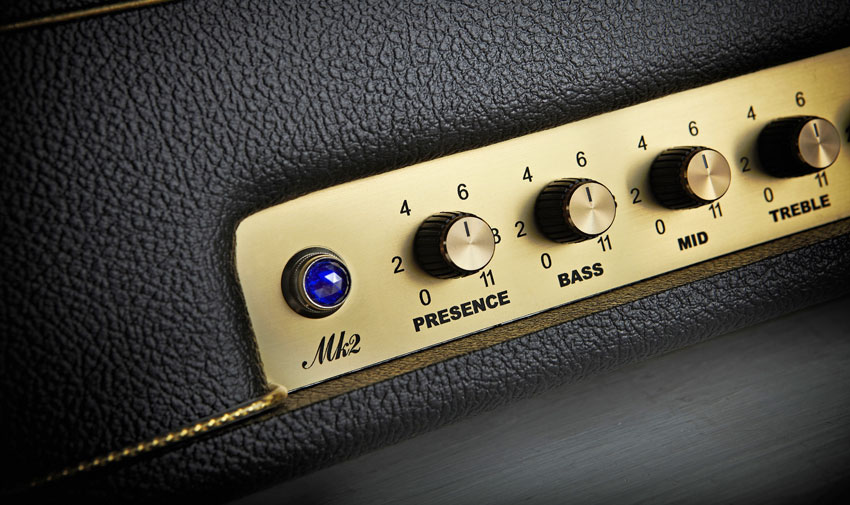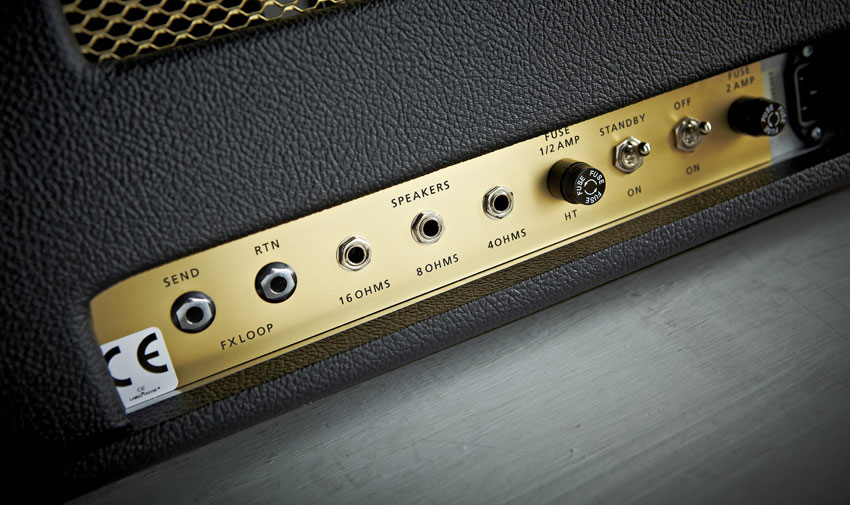MusicRadar Verdict
The Fargen is very close to being our ideal 'Plexi'-style amp. Don't pass up a chance to try one.
Pros
- +
Superlative tone. Top-notch build quality.
Cons
- -
The rear panel location for mains and standby switches.
MusicRadar's got your back

Fargen Olde 800 MK II review

Controls

Rear
There are so many boutique amp builders around right now, it's more likely than ever that somewhere out there, somebody is already making your ultimate amp. And if your idea of 'ultimate' means a straight-up all-valve head that can cover most classic British rock tones from the 1960s to the 1980s, then we have a pretty strong candidate to look at right here. It comes in the shape of the Olde 800 from Sacramento-based Fargen Amplification, and is now available in the UK.
The Olde 800 certainly has the right visuals: the cabinet is high-quality birch ply covered in heavyweight black vinyl accented with gold piping and stringing, while the control panel has the familiar look of a vintage British head. Although the box is substantially larger than the chassis, the amp's proportions are pleasing and it looks the business when it's sat on top of a 4x12.
Its electronics live in a chassis made from neatly folded 3mm thick aircraft grade aluminium - an ideal material for an amp chassis, combining strength and light weight with anti- magnetic properties, which makes it easier to minimise induced hum. The Olde 800's electronic foundation is a substantial GRP eyelet board: a slab of fibreglass-reinforced plastic with small rivets pressed into it at strategic points, into which the component legs are soldered.
"Like some of the amps that inspired it, the Olde 800 is a single-channel design with minimal features and controls"
This is more of an American traditional construction method, compared with the turret board strips that are found in many vintage British amplifiers. But it's robust, and it's easy to service even without a schematic, because all the components and wiring are highly visible. Along with all the front and rear panel parts, the transformers and valve bases bolt to the chassis and are wired either directly to the main board or a couple of small tag strips that carry some of the power supply components.
Fargen uses seriously high quality components, including SoZo Mustard capacitors and custom carbon composition resistors. The valve heater filaments are DC-powered, further reducing the level of hum leaking into the audio circuit.
The all-important mains and output transformers are custom-made for Fargen by Mercury Magnetics, and the standard of wiring and soldering is as good as the very best we've seen, giving the Fargen a reassuring air of invincibility. Despite the heavy- duty cabinet and transformers, the Olde 800 is an easy one- handed carry, thanks mainly to that aluminium chassis, and balances nicely on its single carry handle.
Like some of the amps that inspired it, the Olde 800 is a single-channel design with minimal features and controls. Knobs for gain and volume, with traditional British tone controls, follow a lone input jack. One additional knob operates a Decade switch, which presets gain and EQ for classic Brit rock amp tones from the 60s, 70s and 80s - these loosely translate into JTM45, JMP and JCM800 voicings.
On the rear panel there are jack sockets for the Olde 800's simple series effects loop, speaker outlets for four-, eight- and 16-ohm loads and a pair of mains and standby toggles with associated fuse holders. Less visible, but very useful, is an external bias control and a test point, making it easy to fine- tune the Olde 800's pair of EL34 output valves. All in, the Olde 800 has the look, feel and even the smell of a seriously high-quality product, built and wired by people who know exactly what they're doing.
Sounds
First off, the amp fires up with practically zero mains hum and with only a tiny amount of background hiss. For our tests we used a pair of open- and closed-back 2x12 Celestion Vintage 30-loaded cabs and a variety of guitars, including our old faithful Strat, a PAF-loaded Gibson Les Paul Standard, and a '72 Les Paul Custom that has a fatter and warmer 70s Gibson rock tone. The amp's tone controls work smoothly and interact with no annoying peaks, making it quick and easy to dial in.
"The Decade control is this amp's secret weapon, changing gain and tone at a click to dial in on your favourite era"
The Olde 800 has a wide and almost exaggerated dynamic range and a superb voice that captures the classic vintage Brit rock vibe to perfection. The Decade control is this amp's secret weapon, changing gain and tone at a click to dial in on your favourite era. Select 60s mode, and there's just the right amount of glassy treble. Switch to the 70s mode, and the midrange is more prominent, with a flatter response and a cleaner overall tone, while 80s mode cranks up the gain and midrange for killer leads and crunch rhythm work.
The amp's relatively high gain levels mean it isn't as good for big, fat clean tones, but for earthy touch-sensitive chording the Olde 800 is one of the best we've ever played through. There's a seductive growl on lower strings that really flatters the Strat for Hendrix-style doublestops and chops. However, if you really want to hear the Olde 800 sing, then you need a good Les Paul, and our borrowed '72 Custom proved to be this amp's perfect companion. Used in 80s mode, the Fargen not only sounded great at full throttle, but it also cleaned up superbly with a simple twist of the guitar's volume controls, retaining plenty of the clean volume that's needed to cut through with a live band.
"The Fargen Olde 800 really typifies what a great small-production 'boutique' amp is all about"
The Fargen Olde 800 really typifies what a great small-production 'boutique' amp is all about. It's designed to deliver a particular set of sounds and dynamic responses, in this case classic Brit rock tones that totally hit the bullseye for us.
Like many boutique amps out there, this one is not cheap, but heads that deliver this kind of tone are rare - together with the Olde 800's exceptionally high construction standards, we think that just about justifies the price tag. Competition is harder to find than you'd think - there are many great amps available on the market for similar money, but only a few that do what the Fargen does so effortlessly.
The amp's sounds are more idealised than accurate, meaning that it keeps all the best sonic characteristics and leaves out the bits that were less memorable. It will resonate with many players who remember those sounds from the first time around, as well as younger players who want to discover what it was like back in the days when stompboxes barely existed and a good guitar with a great amp was all you needed. This take on some of the most popular British amps made during that era is a strong reminder that while modern digital modelling has got better, it will only be a facsimile at best. The Fargen, meanwhile, is the real deal - and then some.
With its latest free update, Ableton has finally turned Note into the app I always wanted it to be
Technically capable, but struggle to make your tunes sound musical? 5 simple music theory hacks to make your tracks stand out
"Despite its size, it delivers impressive audio quality and premium functions as well as featuring a good selection of inspired sounds": Roland GO:Piano 88PX review









